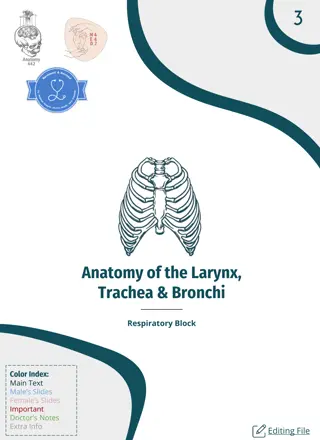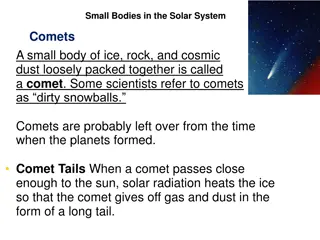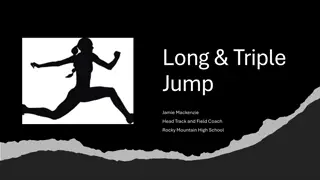Anatomy Basics for Rocky Vista University Class of 2024
Explore the fundamental concepts of anatomy with this informative presentation designed to help students engage in lectures effectively. Covering body systems, from integumentary to circulatory, this guide ensures a solid foundation for anatomy studies. Essential terms and systems are explained to aid both beginners and those refreshing their knowledge.
Download Presentation

Please find below an Image/Link to download the presentation.
The content on the website is provided AS IS for your information and personal use only. It may not be sold, licensed, or shared on other websites without obtaining consent from the author.If you encounter any issues during the download, it is possible that the publisher has removed the file from their server.
You are allowed to download the files provided on this website for personal or commercial use, subject to the condition that they are used lawfully. All files are the property of their respective owners.
The content on the website is provided AS IS for your information and personal use only. It may not be sold, licensed, or shared on other websites without obtaining consent from the author.
E N D
Presentation Transcript
Intro to the Language of Anatomy Rocky Vista University Class of 2024
Intro: The following terms will help you better engage in lectures, most professors will assume that you already know them I made this powerpoint to mainly help those of you who have never taken Anatomy, but even if you have already taken Anatomy please refamiliarize yourself with these terms Parts 2 and 3 are the most critical to grasp, make sure you have those down first, work on the others if you have time before the semester begins
Integumentary system (dermatology) Consists of the skin and its appendages hair, nails, and sweat glands Taken from FA 2019
Skeletal system (osteology) Consists of bones and cartilage; provides our basic shape and support for the body and is what the muscular system acts on to produce movement. Also protects vital organs such as the heart, lungs, and pelvic organs.
Articular system (arthrology) Consists of joints and their associated ligaments, connecting the bony parts of the skeletal system and providing the sites at which movements occur. Taken from FA 2019
Muscular system (myology) Consists of skeletal muscles that act (contract) to move or position parts of the body, or smooth and cardiac muscle that propels, expels, or controls the flow of fluids and contained substance.
Nervous system (neurology) Consists of the central nervous system (brain and spinal cord) and the peripheral nervous system (nerves and ganglia, together with their motor and sensory endings). Controls and coordinates the functions of the organ systems, enabling the body s responses to and activities within its environment.
Circulatory system (angiology) Consists of the cardiovascular and lymphatic systems, which function in parallel to transport the body s fluids.
Cardiovascular system (cardiology) Consists of the heart and blood vessels that propel and conduct blood through the body, delivering oxygen, nutrients, and hormones to cells and removing their waste products. Taken from FA 2019
Lymphatic system Network of lymphatic vessels that withdraws excess tissue fluid (lymph) from the body s interstitial (intercellular) fluid compartment, filters it through lymph nodes, and returns it to the bloodstream.
Digestive (alimentary) system (gastroenterology) Digestive tract from the mouth to anus, with all its associated organs and glands that function in ingestion, mastication (chewing), deglutination (swallowing), digestion, and absorption of food and the elimination of the solid waste (feces) remaining after the nutrients have been absorbed.
Respiratory system (pulmonology) Consist of the air passages and lungs that supply oxygen to the blood for cellular respiration and eliminate carbon dioxide form it. The diaphragm and larynx control the flow of air through the system, which may also produce tone in the larynx that is further modified by the tongue, teeth, and lips into speech.
Urinary system (urology) Consist of the kidneys, ureters, urinary bladder, and urethra, which filter blood and subsequently produce, transport, store, and intermittently excrete urine (liquid waste).
Genital (reproductive) system Consists of the gonads (ovaries and testes) that produce oocytes (eggs) and sperms, the ducts that transport them, and the genitalia that enable their union. After conception the female reproductive tract nourishes and delivers the fetus.
Endocrine system (endocrinology) Consists of specialized structures that secrete hormones, including discrete ductless endocrine glands (such as the thyroid gland) isolated and clustered cells of the gut and blood vessel walls, and specialized nerve endings. Side note: Hormones = organic molecules that are carried by the circulatory system to distant effector cells in all parts of the body. The influence of the endocrine system is thus as broadly distributed as that of the nervous system. Hormones influence metabolism and other processes, such as the menstrual cycle, pregnancy, and parturition (childbirth).
Memory Check: Joints and their associated ligaments are a part of which body system? A: Articular B: Skeletal C: Integumentary D: Nervous E: Endocrine
Memory Check: Joints and their associated ligaments are a part of which body system? A: Articular B: Skeletal C: Integumentary D: Nervous E: Endocrine
Part 2: Anatomical position, planes, and relationship Dorland's Medical Dictionary for Health Consumers. (2007). Retrieved May 24 2019
Anatomical position Refers to the body position as if the person were standing upright with the: Head, gaze (eyes), and toes directed anteriorly (forward) Arms adjacent to the sides with palms facing anteriorly Lower limbs close together with the feet parallel
Median plane (median sagittal plane) The vertical plane passing longitudinally through the body, divides the body into right and left halves. The plane defines the midline of the head, neck, and trunk where it intersects the surface of the body.
Sagittal planes Vertical planes passing through the body parallel to the median plane. Parasagittal is commonly used but is unnecessary because any plane parallel to and on ether side of the median plane is sagittal by definition.
Frontal (coronal) planes Vertical planes passing through the body at right angles to the median plane, dividing the body into anterior (front) and posterior (back) parts.
Transverse planes Horizontal planes passing through the body at right angles to the median and frontal planes, dividing the body into superior (upper) and inferior (lower) parts.
Superior Refers to a structure that is nearer the vertex, the topmost point of the cranium (skull).
Cranial Relates to the cranium and is a useful directional term, meaning toward the head or cranium.
Inferior Refers to a structure that is situated nearer the sole of the foot.
Caudal (tail) Toward the feet or tail region, represented in humans by the coccyx (tail bone), the small bone at the inferior (caudal) end of the vertebral column.
Posterior (dorsal) The back surface of the body or nearer to the back.
Anterior (ventral) The front surface of the body.
Rostral Often used instead of anterior when describing parts of the brain; it means toward the rostrum (beak); however, in humans it denotes nearer to the anterior part of the head.
Medial Used to indicate that a structure is nearer to the median plane of the body.
Lateral Stipulates that a structure is farther away from the median plane.
Dorsum Usually refers to the superior aspect of any part that protrudes anteriorly from the body, such as the dorsum of the tongue, nose, penis, or foot. Also used to describe the posterior surface of the hand, opposite the palm.
Sole The inferior aspect or bottom of the foot, opposite the dorsum, much of which is in contact with the ground when standing barefoot.
Plantar surface Sole of the foot.
Proximal Nearer to the attachment of a limb.
Distal Further from the attachment of a limb.
Ipsilateral Something occurring on the same side of the body as another structure (e.g. right thumb and right great (big) toe)
Contralateral Occurring on the opposite side of the body relative to another structure (e.g. right hand is contralateral to the left hand)
Memory check: My wrist is what in relation to my elbow? A: Proximal B: Ipsilateral C: Contralateral D: Distal E: Inferior
Memory check: My wrist is what in relation to my elbow? A: Proximal (the elbow is proximal to the wrist, or closer to the point of attachment, which is the shoulder in this case) B: Ipsilateral (didn t specify which side I was talking about, just wrist and elbow in general) C: Contralateral (didn t specify which side I was talking about, just wrist and elbow in general) D: Distal (the wrist is further away from the point of attachment for the arm; the shoulder) E: Inferior (although this is a tempting answer, you can move your arm around and make your wrist superior or inferior to your elbow, making distal the most correct answer)
Flexion Bending or decreasing the angle between the bones or parts of the body.
Extension Straightening or increasing the angle between the bones or parts of the body.
Dorsiflexion Flexion at the ankle joint, occurs when walking uphill or lifting the front of the foot and toes off the ground.
Plantarflexion Bends the foot and toes toward the ground, as when standing on your toes. (Think of pressing down on a gas pedal)
Abduction Moving away from the median plane.
Adduction Moving toward the median plane.
Circumduction Circular movement that involves sequential flexion, abduction, extension, and adduction in such a way that the distal end of the part moves in a circle.























